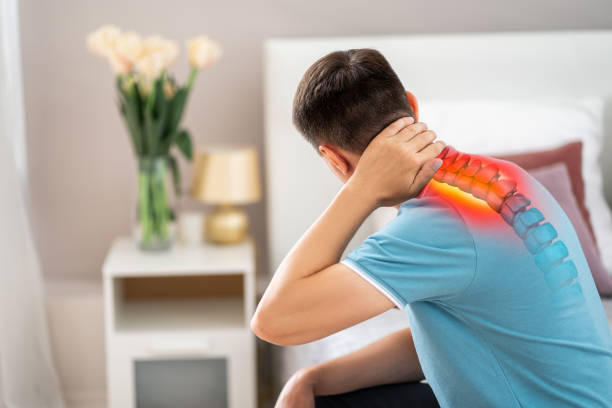Let’s start with something we’ve all experienced at one point or another – neck pain. It’s that annoying stiff neck that ruins your whole day, often after a night spent in a questionable sleeping position, or after you’ve craned your head too long at your phone. What you probably don’t realize is that your neck – technically your cervical spine – is like a finely tuned machine, always working to keep your head upright, flexible, and pain-free. So, what happens when this machine starts acting up?
Meet the Cervical Spine: The Strong and Silent Type
The cervical spine consists of seven vertebrae (C1 through C7), stacked like building blocks, forming the neck section of your spine. The top two vertebrae, C1 (atlas) and C2 (axis), are basically the stars of the show. The atlas holds up your head (think of Atlas from Greek mythology), and the axis helps you say “no” by allowing head rotation. Think of them as the dynamic duo that keeps your neck moving and grooving.
Below the atlas and axis, vertebrae C3 through C7 are the sturdy supporting cast, allowing for forward, backward, and side-to-side movements, while protecting your precious spinal cord. And between each vertebra, intervertebral discs are like tiny shock absorbers, preventing your neck from turning into a creaky mess too soon.
The symptoms and treatment:
The cervical spine, serves as the foundation for neck movement and stability. However, over time, wear and tear can cause cervical spondylosis, a condition often triggered by age-related changes such as dehydrated discs, bone spurs, or herniated discs.
Factors like poor posture, repetitive neck strain, and injuries can also lead to this degeneration. Symptoms can range from mild stiffness to severe pain, radiating to the shoulders and arms. Treatment options include physical therapy, anti-inflammatory medications, and in some cases, surgical intervention for severe compression.
Cervical Spondylosis: Your Neck’s Midlife Crisis

Ah, cervical spondylosis, the bane of anyone with more than a few decades under their belt. Cervical spondylosis refers to the wear-and-tear changes in your neck’s vertebrae, discs, and joints. As we age, our discs tend to dry out and shrink, making room for bone spurs to form. While more than 85% of people over 60 have this condition.
Symptoms of Cervical Spondylosis:
Symptoms can range from a dull, achy neck to full-on pain that shoots down your arms like a shocking reminder that your neck is in charge.
Other symptoms include:
– Neck stiffness
– Pain in the shoulders, arms, or fingers
– Numbness or tingling in your hands
– Headaches
– Muscle weakness
Headaches originating from the neck, difficulty in walking, and loss of bladder or bowel control in severe cases may also occur.
Cervical Spondylitis: What’s the Difference?
Now that we’ve tackled spondylosis, let’s dive into cervical spondylitis. While they may sound similar, cervical spondylitis refers to inflammation in the cervical spine, not wear and tear. It’s often linked to autoimmune conditions like ankylosing spondylitis, which causes chronic inflammation in the joints of the spine.
What Are the Symptoms of Cervical Spondylitis?
Cervical spondylitis symptoms can mimic those of spondylosis, but inflammation takes center stage here:
– Neck pain and stiffness: Persistent and worsens with time.
– Fatigue: Chronic inflammation often leads to overall tiredness.
– Reduced range of motion: You may find it difficult to move your neck in various directions.
– Shoulder and arm pain: The inflammation can radiate into nearby areas.
In more severe cases, the inflammation can lead to fusion of the vertebrae, significantly restricting movement.
What Causes Cervical Spondylitis?
Cervical spondylitis is caused by an autoimmune response, where the immune system mistakenly attacks healthy joint tissue in the spine. Genetic factors and family history of autoimmune diseases can increase your risk. Other triggers may include infections or stress, which can exacerbate inflammation.
How Is Cervical Spondylitis Diagnosed?
Doctors may use the following methods to diagnose cervical spondylitis:
– Physical examination: Your doctor will assess your neck’s range of motion and check for any tenderness or swelling.
– Blood tests: These can identify markers of inflammation, like C-reactive protein (CRP) and erythrocyte sedimentation rate (ESR).
– Imaging tests: X-rays, MRIs, or CT scans can provide a detailed view of inflammation and any fusion of the vertebrae.
– Genetic testing: For conditions like ankylosing spondylitis, genetic markers such as HLA-B27 may be tested.
What Are the Treatment Options for Cervical Spondylitis?
Managing cervical spondylitis is about controlling inflammation and relieving symptoms:
– Medications: Nonsteroidal anti-inflammatory drugs (NSAIDs) are commonly prescribed to reduce inflammation and pain. For autoimmune-related cases, disease-modifying antirheumatic drugs (DMARDs) or biologics may be used to suppress the immune system.
– Physical therapy: Regular exercises can help maintain mobility and prevent stiffness.
– Lifestyle modifications: Anti-inflammatory diets, stress reduction, and regular exercise can help manage symptoms.
For severe cases where vertebrae have fused, surgery may be necessary to restore some mobility or reduce nerve compression.
Quick Q&A: Cervical Spondylosis & cervical spondylitis Edition
Q.Can it cause headaches?
-Absolutely. Those bone spurs like to mess with the nerves around your neck, which can lead to headaches.
Q.Will my neck ever feel “normal” again?
– With proper care, yes, though you might have the occasional flare-up. Staying active and practicing good posture can go a long way.
Q. Can cervical spondylitis affect other parts of the spine?
-Yes, cervical spondylitis can extend to other areas of the spine, leading to pain and stiffness in the lower back or hips.
Q. Is cervical spondylitis linked to other autoimmune diseases?
-Yes, cervical spondylitis is often associated with autoimmune conditions like ankylosing spondylitis and rheumatoid arthritis.
Your neck is pretty amazing, but like any hardworking part of the body, it can wear out over time. While cervical spondylosis may be inevitable for many of us, it doesn’t have to spell disaster. So, next time your neck feels sore, don’t just brush it off as “sleeping funny.” Treat it like the important, hardworking part of your body that it is!

